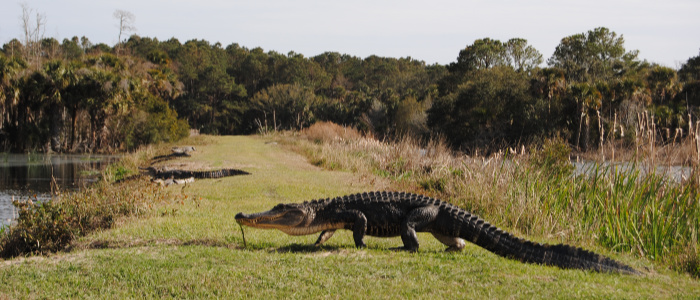How much do you know about the American alligator (Alligator mississippiensi)? This species has had a rocky history, but were put on a path to success thanks to the Endangered Species Act (ESA).
Decades ago, this reptile (the largest in North America, in fact!) was hunted almost to extinction. Under law that led to the ESA, their habitat was put under protection, as were they from hunting. Twenty years later, their populations were stable enough for them to be removed from the endangered species list, and they’ve remained off of it ever since.
South Carolina has the second densest population of American alligators on a remote barrier island just 40-minutes from downtown Charleston, Bulls Island. We’re lucky enough to have access to seeing this wildlife success story thanks to Coastal Expeditions and their new “Bulls Island Alligator Walk” tours!
We sat down with Olivia DePue from Coastal Expeditions, our official adventure outfitter. Olivia’s job immerses her into the landscape of the Lowcountry through adventurous treks by boat, kayak or paddleboard. One of her favorite places for experiencing the wild side of our region is Bulls Island, and she has the inside scoop on its scaly residents!

Where would we typically find alligators?
Alligators live in freshwater environments and prefer still or slow-moving water. I occasionally see alligators in swamps or slow-flowing rivers, but most commonly near large ponds. However, I’ve seen alligators venture briefly into the saltwater to snack on horseshoe crabs, blue crabs and fish, but they usually don’t stray too far from home.
Do their locations or habits change with the seasons?
Alligators are ectothermic animals (meaning cold-blooded), so they take on the temperature of the world around them. Because of that, you’ll mostly find them in the water during the summer months to avoid overheating. In the winter they tend to brumate (similar to hibernation) underwater or in burrows. (Fun fact from the Aquarium: Have you ever seen them basking in the sunlight with their mouths wide open? This is another temperature-driven behavior! This sunbathing position warms them up, and the open-jawed manner cools them down.)
What can you tell us about the alligators on Bulls Island?
There’s a spot on Bulls Island called Jack’s Creek where alligators congregate by the dozens. On Fridays in November, we’re hosting special naturalist-led hiking tours of Bulls Island to get you closer to these radical reptiles and learn a bit more about their characteristics and habits!


